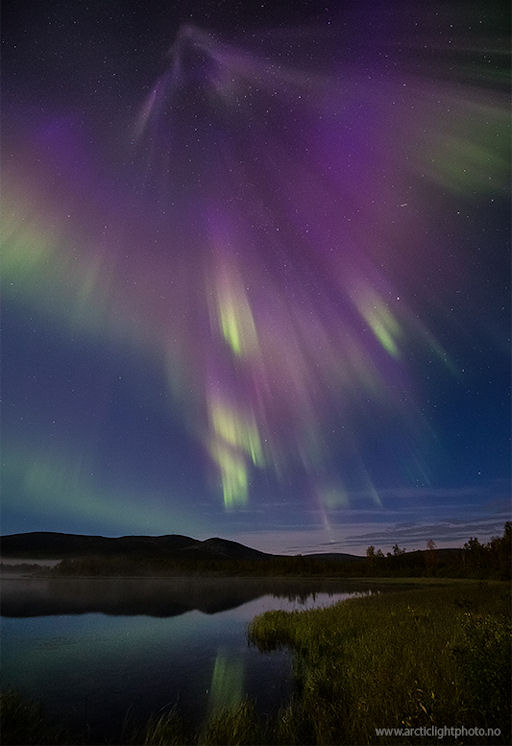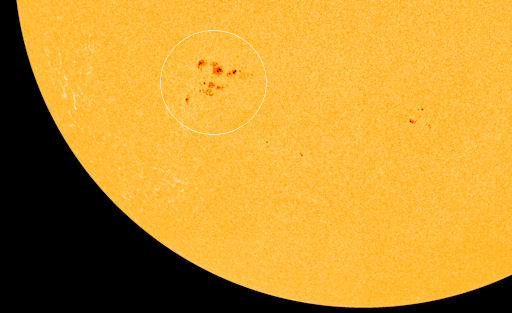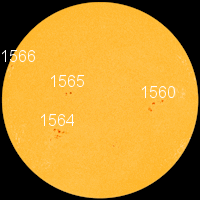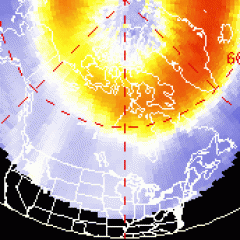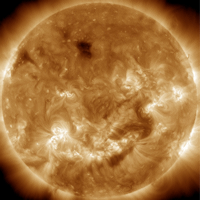SUBSIDING STORM: A geomagnetic storm that began on Sept. 3rd when a coronal mass ejection (CME) hit Earth's magnetic field is fitfully subsiding. The impact at 1200 UT (5 am PDT) induced significant ground currents in the soil of northern Scandinavia and sparked bright auroras around the Arctic Circle. Ole C. Salomonsen photographed the display over Naimakka, Finland, on Sept. 4th:
"There I was standing all alone deep in the Finish forest, just in awe of this display of light above my head," says Salomonsen. "This is just one of many images of spectacular auroras I shot on this wonderful night."
Stay tuned to the aurora gallery for new photos of the storm. Aurora alerts: text, phone.
SUNSPOT AR1564: The next strong flare could be just around the corner. Sunspot AR1564 is growing rapidly and has developed a 'beta-gamma' magnetic field that harbors energy for M-class flares. NASA's Solar Dynamics Observatory took this picture of the active region during the early hours of Sept. 4th:
NOAA forecasters estimate a 40% chance of M-flares during the next 24 hours. Any eruptions will likely be Earth-directed as the active region is turning toward our planet. Solar Flare alerts: text, phone.

![]()
Solar wind
speed: 451.9 km/sec
density: 2.2 protons/cm3
explanation | more data
Updated: Today at 1507 UT
![]()
X-ray Solar Flares
6-hr max: C1 0947 UT Sep04
24-hr: C2 0507 UT Sep04
explanation | more data
Updated: Today at: 1500 UT
![]()
![]()
![]()
Daily Sun: 04 Sep 12
![]()
![]()
Sunspot 1564 is suddenly growing. It has a 'beta-gamma' magnetic field that harbors energy for M-class solar flares. Credit: SDO/HMI
![]()
![]()
![]()
Sunspot number: 156
What is the sunspot number?
Updated 04 Sep 2012
Spotless Days
Current Stretch: 0 days
2012 total: 0 days (0%)
2011 total: 2 days (<1%)
2010 total: 51 days (14%)
2009 total: 260 days (71%)
Since 2004: 821 days
Typical Solar Min: 486 days
Update 04 Sep 2012
The Radio Sun
10.7 cm flux: 142 sfu
explanation | more data
Updated 04 Sep 2012
![]()
![]()
![]()
Current Auroral Oval:
![]()
Switch to: Europe, USA, New Zealand, Antarctica
Credit: NOAA/POES
![]()
![]()
![]()
Planetary K-index
Now: Kp= 2 quiet
24-hr max: Kp= 5 storm
explanation | more data
![]()
Interplanetary Mag. Field
Btotal: 8.0 nT
Bz: 0.9 nT south
explanation | more data
Updated: Today at 1507 UT
![]()
![]()
![]()
Coronal Holes: 04 Sep 12
![]()
![]()
There are no large coronal holes on the Earthside of the sun. Credit: SDO/AIA.

